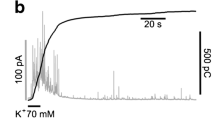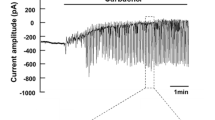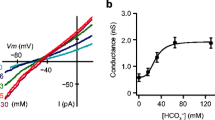Abstract.
Secretion of Cl– requires the presence of a K+ conductance to hyperpolarize the cell, and to provide the driving force for Cl– exit via luminal Cl– channels. In the exocrine pancreas Cl– secretion is mediated by an increase in cytosolic Ca2+ ([Ca2+]i). Two types of Ca2+-activated K+ channels could be shown in pancreatic acinar cells of different species. However, there are no data on Ca2+-activated K+ channels in rat pancreatic acini. Here we examine the basolateral K+ conductance of freshly isolated rat pancreatic acinar cells in cell-attached and cell-excised patch-clamp experiments. Addition of carbachol (CCH, 1 µmol/l) to the bath led to the activation of very small conductance K+ channels in cell-attached patches (n=27), producing a noisy macroscopic outward current. The respective outward conductance increased significantly by a factor of 2.1±0.1 (n=27). Noise analysis revealed a Lorentzian noise component with a corner frequency (f c) of 30.3±3.5 Hz (n=19), consistent with channel activity in these patches. The estimated single-channel conductance was 1.5±0.4 pS (n=19). In cell-excised patches (inside out) from cells previously stimulated with CCH, channel activity was only observed in the presence of K+ in the bath solution. Under these conditions f c was 47.6±11.9 Hz (estimated single-channel conductance 1.1±0.2 pS, n=20). The current/voltage relationship of the noise showed weak inward rectification and the reversal potential shifted towards E K + when Na+ in the bath was replaced by K+. Channel activity in cell-excised patches was slightly reduced by 10 mmol/l Ba2+ (23.6±2.1% of the total outward current) and was completely absent when K+ in the bath was replaced by Na+. Reduction of the [Ca2+]i from 1 mmol/l to 1 µmol/l in cell-excised experiments decreased the current by 52.3±12.3% (n=5). Expression of KVLQT1, one of the possible candidates for a small-conductance K+ channel in rat pancreatic acinar cells, was shown by reverse transcriptase polymerase chain reaction (RT-PCR). In fact, a KVLQT-blocker (chromanol 293B) reduced channel activity in seven excised patches. These data suggest that CCH activates very small conductance K+ channels in rat pancreatic acinar cells, most likely via an increase in [Ca2+]i.
Similar content being viewed by others
Author information
Authors and Affiliations
Additional information
Received after revision: 7 May 1999
Electronic Publication
Rights and permissions
About this article
Cite this article
Köttgen, M., Hoefer, A., Kim, .S. et al. Carbachol activates a K+ channel of very small conductance in the basolateral membrane of rat pancreatic acinar cells. Pflügers Arch – Eur J Physiol 438, 597–603 (1999). https://doi.org/10.1007/s004249900070
Received:
Accepted:
Issue Date:
DOI: https://doi.org/10.1007/s004249900070




